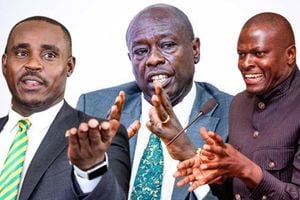Inside Raila’s plan to tackle soaring public debt

Raila Odinga.
Azimio la Umoja One Kenya flagbearer Raila Odinga has promised to overhaul the nation’s public debt management system to ease pressure on Kenyans.
The Parliamentary Budget Office earlier this year projected that Kenya could spend up to Sh1.36 trillion in debt service by July. While public debt crossed Sh8 trillion in December last year, the Treasury has requested Parliament to raise the ceiling from Sh9 trillion to Sh10 trillion.
In his manifesto for the 2022-2027 period, Mr Odinga says he will restructure and re-profile Kenya’s debt portfolio to reduce the burden and achieve sustainability.
He will only borrow “for purpose of viable projects that will finance the repayments and debt servicing and secure inter-generational equity”, while on the other hand, “aggressively pursuing debt relief negotiations” on the already huge public debt burden that President Kenyatta’s administration will be leaving behind.
Mr Odinga promises to “reduce the pace of debt accumulation and develop policies that support sustainable debt levels and terms”, while strengthening policies and frameworks on debt management.
He has vowed to go slow on borrowing compared to the Jubilee administration since it assumed power in 2013, while attempting to appease the youth who have been particularly wary of the future impacts of the rapidly growing public debt.
As he pursues a sustainable public debt management, Mr Odinga has promised various incentives such as waivers, tax holidays and reductions for businesses as a way to encourage their participation and enlisting with the Kenya Revenue Authority, which could limit the government’s revenues.
The manifesto proposes to waive regulatory and other licensing fees for new youth-led manufacturing innovations and give incentives to Kenyans, including those in the diaspora to invest in the country.
“Review the taxation regime to lower the tax burden for micro, small and medium-sized enterprises and make it predictable. Guarantee a three-year tax holiday to MSMEs startups, upon registration with KRA,” states the manifesto.
Tax holidays
While recognising the vital role played by MSMEs in the economy, which contribute 40 per cent to GDP and employ nearly 15 million people, Mr Odinga says tax holidays are the best way to attract such businesses into the tax dragnet.
“The sector remains highly informal as only 20 per cent of the 7.4 million MSMEs operate as licensed entities,” states the manifesto, while proposing reforms in the current tax regime.
Mr Ken Gichinga, chief economist at Mentoria Economics, argues that while tax incentives could yield more revenue for the government after some time, the real issue Mr Odinga must address is a drastic shift from excessive external borrowing and instead stabilise the domestic market.
“There is need to reduce reliance on external debts since they are exposed to volatilities in foreign exchange rates, thus posing huge risks to the economy. Also, by virtue of Kenya now being a lower middle income economy, its access to concessional loans is limited,” he said.
He also noted that it was not guaranteed that the tax incentives will necessarily yield sustainable increase in revenues. Azimio has lined up incentives for MSMEs, from startups to the manufacturing sector, to encourage investments.
“Improve the investment climate by addressing corruption, high cost of doing business, insecurity and delays in processing investment approvals, amongst others. Put in place an attractive taxation regime,” states the manifesto.
Key issues that will determine the weight of public debt taxpayers carry if Mr Odinga is elected will depend on the success of his pursuit of debt relief for the current loans, and if he keeps his word to borrow only to fund projects that can repay themselves.





